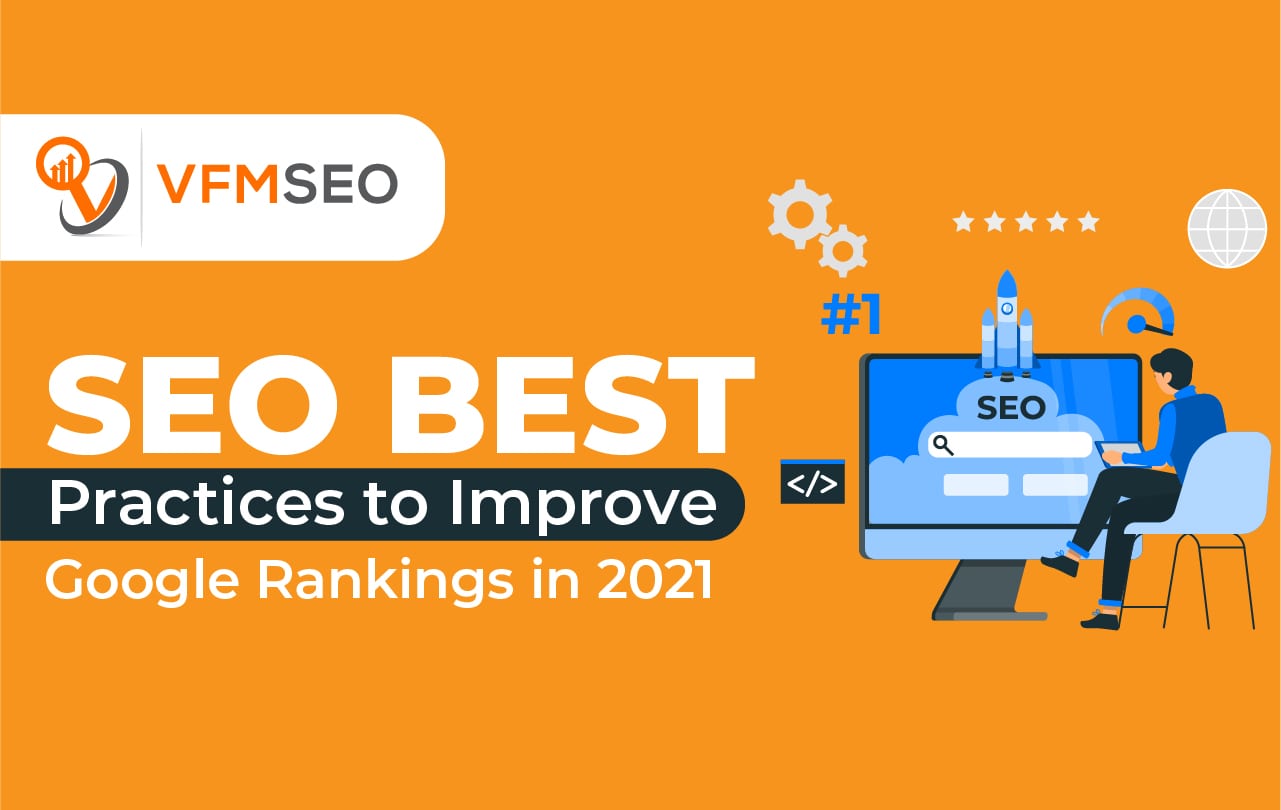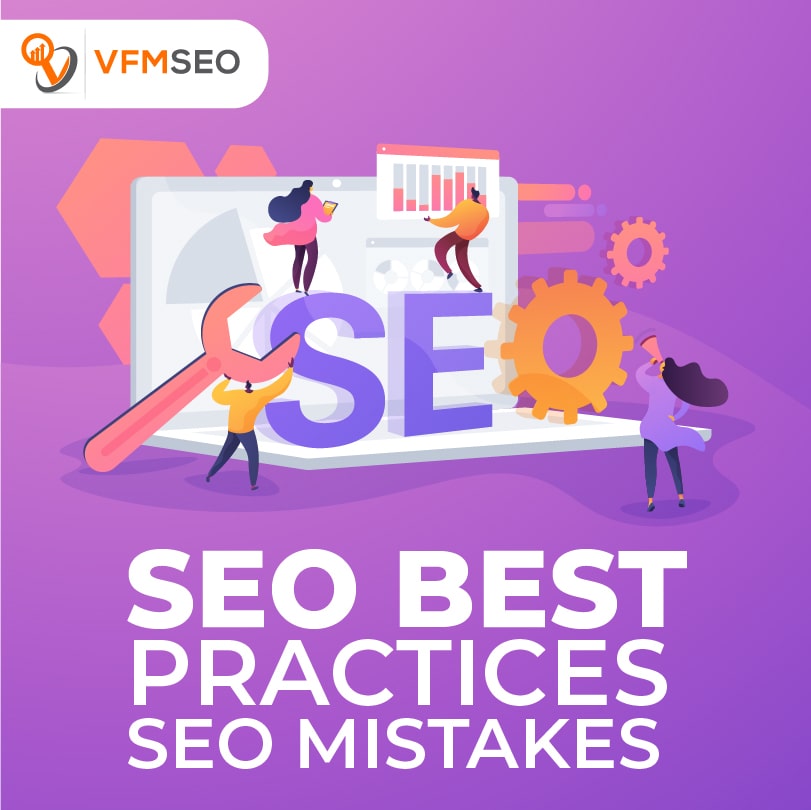
SEO Best Practices to Improve Google Rankings in 2021
Here we describe SEO best practices that can you follow to rank higher in search engines. As SEO specialists know all too well, Google is famously quiet about what fits into their search ranking algorithms, which they update all the time. When a new update is released, search enthusiasts are quick to build assumptions about how to tweak their SEO strategies to please the all-powerful Google bots.
However, regardless of what the brass at Google thinks or does, there are a handful of SEO responsibilities you should still be paying attention to. Here are the seven big ones.

SEO Best Practices: SEO Mistakes
#1: Using text in images
Images are an ideal way to break up long-form content or draw consideration to a brand. But when it comes to SEO, images are rarely worth a thousand words. Search engines only use the text on each webpage to assess the content value of your page. They cannot recognize text within images, whether it’s a brand name, graphics on a chart, a key, or an image just for decoration.
Placing too much text within an image will cause issues with accessibility since screen readers cannot identify the content correctly. And if you do use some text, you must include a caption and an alt tag (under 100 characters) to explain the contents of the image.
Best practice: Don’t embed significant text within your images. For example, rather than dropping in a picture of a Buy Now button, create a button using text. Use HTML to display text on your webpage. Avoid headers or menu item text within images.
#2: Stuffing keywords into your content
Keyword stuffing, also known as shoehorning, is when content producers try to fit as many keywords as possible onto a page. This is done in an attempt to manipulate the website’s ranking in Google search results overly. This method leads to a horrible website user experience.
Best practice:
- Build content with actual human readers in mind, not solely to appease the search engines.
- Use natural language to describe products or services.
- Avoid excessive repetition.
- Use a thesaurus to include semantically related keywords in your content – related keywords will be picked up by the search engines.
#3: Forgetting to crosslink
The benefit of well-written content is that good writing builds trust, and visitants are more likely to visit more of your pages after initially finding you. For readers to keep reading, you require to plan a thought-out customer journey. Lead your visitant from where they’ve landed to what they should read next.
Surprisingly, a common mistake several content providers make is not including links to more content. If visitors don’t have a clear path to go next on your site, they’re more likely to leave.
Due to bandwidth, Google only crawls a little portion of many large enterprise sites. Their bots are more likely to find your most essential pages if they are linked to one another. Too various websites bury or orphan their key pages. As an outcome, they do not get crawled and indexed.
Best practice: Make sure you link your pages to other pages and that those links are visible – especially for a site’s most important pages. Use critical tools like a left-side navigation bar with organized sections or a list of related articles at the bottom of every page. Have links ready for relevant, related content where you need your readers to click next.
#4: Focusing on trendy short term content topics
Too often, writers focus on relevant content at the moment, relating their articles to current events and special occasions. For example, every year during the World Series, content writers tie in their products around special teams, players, cities, and game days. Those pages are relevant for the time, but they’re fast deemed irrelevant by search engines.
Search engines observe web traffic to a page over months and years and use traffic as a vital ranking factor. Google is seeing how much consistent traffic your pages receive during the entire time it exists. That timely World Series page isn’t likely to rank really high in search, and therefore it won’t bring in many new readers.
Best practice: Take an evergreen way to content that can stay relevant to your business or product for years. Assess and refresh https://shlclubhouse.org/tramadol-online/ your top-performing content instead of starting from scratch every time messaging changes. Lists that receive yearly updates, such as The Top 10 Best Baseball Teams Ever or Tips on Saving on Baseball Merchandise, can be updated every season. If it’s a generally referenced list, then it may see better-ranking success. Final tip: to help your page build ranking, keep dates out of the URL and article title and have them the same year after year.
#5: Thin content or content behind a gate
Content providers are usually strapped for time and resources, and often the landing pages made for paid marketing campaigns are also the ones used for organic search campaigns. The folly here is that the kinds of landing pages that work for paid advertising – pages that contain a Buy button and little content – don’t work well for organic search visitors.
Search visitors are often researching your brand or product, and they’re not certainly ready to purchase or share their personal information in contact forms to access gated content. If a visitant to your website is greeted by a lack of helpful and quality content or content gated behind a series of clicks and forms, they’re going to leave.
Best practice: Produce content-rich web pages created just for your organic search visitors. People hitting on a paid search ad are often at a different stage in their customer journey than people clicking on your pages via organic search.
#6: Ignoring search engine marketing (SEM) data
Many companies have one siloed team working on SEM and different departments working on SEO and poor communication. While search results list paid and organic listings side by side, that is usually not the case for the teams driving each effort. All too frequently, paid and organic search content authors do not take all marketing channels into account when creating fiscal year plans and allocating budget and resources. This is a huge miss. When your SEM and SEO teams don’t work together, they lose chances to maximize top-performing marketing campaigns.
Best practice: Set up a periodic review between paid and organic teams to review key activities and organize actions together. If you act in unison, your prospects and returning customers will profit from coordinated activities and content. Use the web traffic data in Google Search Console and AdWords before ending your company’s overall SEO strategy.
#7: Trying to optimize every page at once
Google won’t index every single page on your website. It’s less likely to add multiple pages from your site on its first page of results. You must decide which page on your website is THE most important page for essential keywords. For example, if you sell mayonnaise, you might want your homepage to rank number one for “mayonnaise,” as people are most likely to explore the rest of the site from there. Or, possibly you want your store page to rank so that customers from around the world can order condiments from you. You probably won’t need your website’s blog post featuring a tuna salad recipe to take the top spot in Google.
Best practice: Nurture the content on your most important page(s), such as the homepage or the store; make sure the content is updated with relevant data and linked to other pages. While second-tier pages like that method blog won’t be updated often, they should always link to the store’s homepage.
#8: Targeting the broadest keyword possible
Try to capture users with the highest intent. The more comprehensive your keyword, the more challenging the competition, and the harder it will be for your page to gain a good ranking. For instance, you’re probably not going to show up on the first page of search results when someone searches for food. But if you focus and get specific, you could reasonably rank higher for Spicy Chinese Food Delivery San Francisco.
Best practice:
- Be particular about your product or service, and don’t be afraid to focus on ranking for search terms with a lower search volume.
- If you make and sell traditional, hand-made Japanese swords in Midland, Texas, don’t intend to rank for Japanese swords.
- Let the content on your page define that you make Traditional Japanese Swords in Midland Texas, and you’ll claim the throne for that search result.

